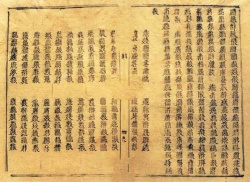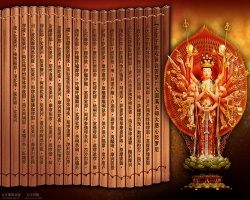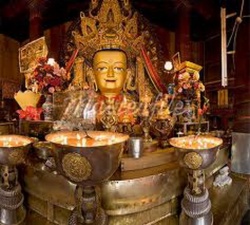Digha Nikaya
The Digha Nikaya is the first book in the Sutta Pitaka, the first division of the Tipitaka, the sacred scriptures of Buddhism. Digha means ‘long’ and nikàya means ‘book’ or ‘collection’ and this name is used because the thirty four discourses or suttas in this book are lengthy – the longest being forty six pages in the English translation. Nearly half the discourses in the Digha Nikaya take the form of debates or dialogues between the Buddha and others. Some of these debates are very lively and give a fascinating glimpse of how the Buddha used logic, dialectic, reason and gentle persuasion to win people to his point of view. As in most of the other divisions in the Tipitaka, the discourses in the Digha Nikaya do not seem to be arranged in any particular order.
The Digha Nikaya (dīghanikāya; "Collection of Long Discourses") is a Buddhist scripture, the first of the five nikayas, or collections, in the Sutta Pitaka, which is one of the "three baskets" that compose the Pali Tipitaka of Theravada Buddhism. Some of the most commonly referenced suttas from the Digha Nikaya include the Maha-parinibbana Sutta (DN 16), which described the final days and death of the Buddha, the Sigalovada Sutta (DN 31) in which the Buddha discusses ethics and practices for lay followers, and the Samaññaphala (DN 2), Brahmajala Sutta (DN 1) which describes and compares the point-of-view of Buddha and other ascetics in India about the universe and time (past, present, and future); and Potthapada (DN 9) Suttas, which describe the benefits and practice of samatha meditation.
Structure and Contents
The Digha Nikaya consists of 34 discourses, broken into three groups:
- Silakkhandha-vagga—The Division Concerning Morality (suttas 1-13); named after a tract on monks' morality that occurs in each of its suttas (in theory; in practice it is not written out in full in all of them); in most of them it leads on to the jnanas (the main attainments of samatha meditation), the cultivation of psychic powers and becoming an arahant
- Maha-vagga—The Great Division (suttas 14-23)
- Patika-vagga—The Patika Division (suttas 24-34)
Suttas of the Digha Nikaya
| Sutta number | Pali title | English title | Description |
|---|---|---|---|
| DN 1 | Brahmajāla Sutta | Mainly concerned with 62 types of wrong view | |
| DN 2 | Sāmaññaphala Sutta | The Fruits of the Contemplative Life | King Ajatasattu of Magadha asks the Buddha about the benefits in this life of being a samana ("recluse" or "renunciant"); the Buddha's reply is in terms of becoming an arahant |
| DN 3 | Ambaṭṭha Sutta | Ambattha the Brahmin is sent by his teacher to find whether the Buddha possesses the 32 bodily marks, but on arrival he is rude to the Buddha on grounds of descent (caste); the Buddha responds that he is actually higher born than Ambattha by social convention, but that he himself considers those fulfilled in conduct and wisdom as higher. | |
| DN 4 | Soṇadaṇḍanta Sutta | The Buddha asks Sonadanda the Brahmin what are the qualities that make a Brahmin; Sonadanda gives five, but the Buddha asks if any can be omitted and argues him down to two: morality and wisdom. | |
| DN 5 | Kūṭadanta Sutta | Kutadanta the Brahmin asks the Buddha how to perform a sacrifice; the Buddha replies by telling of one of his past lives, as chaplain to a king, where they performed a sacrifice which consisted of making offerings, with no animals killed. | |
| DN 6 | Mahāli Sutta | In reply to a question as to why a certain monk sees divine sights but does not hear divine sounds, the Buddha explains that it is because of the way he has directed his meditation. | |
| DN 7 | Jāliya Sutta | Asked by two Brahmins whether the soul and the body are the same or different, the Buddha describes the path to wisdom, and asks whether one who has fulfilled it would bother with such questions | |
| DN 8 | Kassapa Sīhanāda Sutta (alt:Maha Sīhanāda or Sīhanāda Sutta) |
The word sihanada literally means 'lion's roar': this discourse is concerned with asceticism. | |
| DN 9 | Poṭṭhapāda Sutta | About Potthapada | Asked about the cause of the arising of saññā, usually translated as perception, the Buddha says it is through training; he explains the path as above up to the jhanas and the arising of their perceptions, and then continues with the first three formless attainments; the sutta then moves on to other topics, the self and the unanswered questions. |
| DN 10 | Subha Sutta | Ananda describes the path taught by the Buddha. | |
| DN 11 | Kevaṭṭa Sutta alt: Kevaḍḍha Sutta |
To Kevatta | Kevaddha asks the Buddha why he does not gain disciples by working miracles; the Buddha explains that people would simply dismiss this as magic and that the real miracle is the training of his followers. |
| DN 12 | Lohicca Sutta | To Lohicca | On good and bad teachers. |
| DN 13 | Tevijja Sutta | Asked about the path to union with Brahma, the Buddha explains it in terms of the Buddhist path, but ending with the four brahmaviharas; the abbreviated way the text is written out makes it unclear how much of the path comes before this; Robert Gombrich has argued that the Buddha was meaning union with Brahma as synonymous with nirvana. | |
| DN 14 | Mahāpadāna Sutta | Tells the story of a past Buddha up to shortly after his enlightenment; the story is similar to that of Gautama Buddha. | |
| DN 15 | Mahanidāna Sutta | The Great Causes Discourse | On dependent origination. |
| DN 16 | Mahaparinibbāna Sutta | The Last Days of the Buddha | Story of the last few months of the Buddha's life, his death and funeral, and the distribution of his relics. |
| DN 17 | Mahasudassana Sutta | Story of one of the Buddha's past lives as a king. The description of his palace has close verbal similarities to that of the Pure Land, and Rupert Gethin has suggested this as a precursor | |
| DN 18 | Janavasabha Sutta | King Bimbisara of Magadha, reborn as the god Janavasabha, tells the Buddha that his teaching has resulted in increased numbers of people being reborn as gods. | |
| DN 19 | Maha-Govinda Sutta | Story of a past life of the Buddha. | |
| DN 20 | Mahasamaya Sutta | The Great Meeting | Long versified list of gods coming to honour the Buddha |
| DN 21 | Sakkapañha Sutta | Sakka's Questions | The Buddha answers questions from Sakka, ruler of the gods (a Buddhist version of Indra) |
| DN 22 | Mahasatipaṭṭhāna Sutta | The Great Discourse on the Foundations of Mindfulness | The basis for one of the Burmese vipassana meditation traditions; many people have it read or recited to them on their deathbeds. |
| DN 23 | Pāyāsi Sutta alt: Payasi Rājañña Sutta |
Dialogue between the skeptical Prince Payasi and a monk. | |
| DN 24 | Pāṭika Sutta alt:Pāthika Sutta |
A monk has left the order because he says the Buddha does not work miracles; most of the sutta is taken up with accounts of miracles the Buddha has worked | |
| DN 25 | Udumbarika Sihanada Sutta alt: Udumbarika Sutta |
Another discourse on asceticism. | |
| DN 26 | Cakkavatti Sihanada Sutta | The Wheel-turning Emperor | Story of humanity's decline from a golden age in the past, with a prophecy of its eventual return. |
| DN 27 | Aggañña Sutta | Another story of humanity's decline. | |
| DN 28 | Sampasādaniya Sutta | Sariputta praises the Buddha. | |
| DN 29 | Pāsādika Sutta | The Buddha's response to the news of the death of his rival, the founder of Jainism. | |
| DN 30 | Lakkhaṇa Sutta | Explains the actions of the Buddha in his previous lives leading to his 32 bodily marks; thus it describes practices of a bodhisattva (perhaps the earliest such description). | |
| DN 31 | Sigalovada Sutta alt:Singala Sutta, Singalaka Sutta or Sigala Sutta |
To Sigala/The Layperson's Code of Discipline | Traditionally regarded as the lay vinaya. |
| DN 32 | Āṭānāṭiya Sutta | [[The Discourse}} on Atanatiya]] | Gods give the Buddha a poem for his followers, male and female, monastic and lay, to recite for protection from evil spirits; it sets up a mandala or circle of protection and a version of this sutta is classified as a tantra in Tibet and Japan |
| DN 33 | Saṅgāti Sutta | L. S. Cousins has tentatively suggested that this was the first sutta created as a literary text, at the Second Council, his theory being that sutta was originally a pattern of teaching rather than a body of literature; it is taught by Sariputta at the Buddha's request, and gives lists arranged numerically from ones to tens (cf. Anguttara Nikaya); a version of this belonging to another school was used as the basis for one of the books of their Abhidharma Pitaka. | |
| DN 34 | Dasuttara Sutta | Similar to the preceding sutta but with a fixed format; there are ten categories, and each number has one list in each; this material is also used in the Patisambhidamagga. |
Correspondence with the Dīrgha Āgama
The Digha Nikaya corresponds to the Dīrgha Āgama found in the Sutra Pitikas of various Sanskritic early Buddhists schools, fragments of which survive in Sanskrit. A complete version of the Dīrgha Āgama of the Dharmagupta school survives in Chinese translation by the name Cháng Ahánjīng 長阿含經. It contains 30 sūtras in contrast to the 34 suttas of the Theravadin Dīgha Nikāya. In addition, portions of the Sarvāstivādin school's Dīrgha Āgama survive in Sanskrit and in Tibetan translation.
Translations
Complete Translations:
- Dialogues of the Buddha, tr T. W. and C. A. F. Rhys Davids, 1899–1921, 3 volumes, Pali Text Society[1]
- Thus Have I Heard: the Long Discourses of the Buddha, tr Maurice Walshe, Wisdom Pubs, 1987; later reissued under the original subtitle; ISBN 0-86171-103-3
Selections:
- The Buddha's Philosophy of Man, Rhys Davids tr, rev Trevor Ling, Everyman, out of print; 10 suttas including 2, 16, 22, 31
- Long Discourses of the Buddha, tr Mrs A. A. G. Bennett, Bombay, 1964; 1-16
- Ten Suttas from Digha Nikaya, Burma Pitaka Association, Rangoon, 1984; 1, 2, 9, 15, 16, 22, 26, 28-9, 31
The Digha Nikaya, or "Collection of Long Discourses" (Pali digha = "long") is the first division of the Sutta Pitaka, and consists of thirty-four suttas, grouped into three vaggas, or divisions:
- Silakkhandha-vagga — The Division Concerning Morality (13 suttas)
- Maha-vagga — The Large Division (10 suttas)
- Patika-vagga — The Patika Division (11 suttas)
An excellent modern translation of the complete Digha Nikaya is Maurice Walshe's The Long Discourses of the Buddha: A Translation of the Digha Nikaya (formerly titled: Thus Have I Heard) (Boston: Wisdom Publications, 1987). A fine anthology of selected suttas is Handful of Leaves (Vol. 1), by Thanissaro Bhikkhu (distributed by the Sati Center for Buddhist Studies).
The translator appears in the square brackets []. The braces {} contain the volume and starting page number in the PTS romanized Pali edition.
- DN 1: Brahmajāla Sutta — The All-embracing Net of Views {D i 1} Bodhi.
In this important sutta, the first in the Tipitaka, the Buddha describes sixty-two philosophical and speculative views concerning the self and the world that were prevalent among spiritual seekers of his day. In rejecting these teachings — many of which thrive to this day — he decisively establishes the parameters of his own.
- DN 2: Samaññaphala Sutta — The Fruits of the Contemplative Life {D i 47} Thanissaro.
King Ajatasattu asks the Buddha, "What are the fruits of the contemplative life, visible in the here and now?" The Buddha replies by painting a comprehensive portrait of the Buddhist path of training, illustrating each stage of the training with vivid similes.
- DN 9: Potthapada Sutta — About Potthapada {D i 178} Thanissaro.
The wandering ascetic Potthapada brings to the Buddha a tangle of questions concerning the nature of perception. The Buddha clears up the matter by reviewing the fundamentals of concentration meditation and showing how it can lead to the ultimate cessation of perception.
- DN 11: Kevatta (Kevaddha) Sutta — To Kevatta {D i 211} Thanissaro.
This discourse explores the role of miracles and conversations with heavenly beings as a possible basis for faith and belief. The Buddha does not deny the reality of such experiences, but he points out that — of all possible miracles — the only reliable one is the miracle of instruction in the proper training of the mind.
As for heavenly beings, they are subject to greed, anger, and delusion, and so the information they give — especially with regard to the miracle of instruction — is not necessarily trustworthy. Thus the only valid basis for faith is the instruction that, when followed, brings about the end of one's own mental defilements. The tale that concludes the discourse is one of the finest examples of the early Buddhist sense of humor. [This summary provided by the translator.]
- DN 12: Lohicca Sutta — To Lohicca {D i 224} Thanissaro.
A non-Buddhist poses some good questions: If Dhamma is something that one must realize for oneself, then what is the role of a teacher? Are there any teachers who don't deserve some sort of criticism? The Buddha's reply includes a sweeping summary of the entire path of practice.
- DN 15: Maha-nidana Sutta — The Great Causes Discourse {D ii 55} Thanissaro.
One of the most profound discourses in the Pali canon, which gives an extended treatment of the teachings of dependent co-arising (paticca samuppada) and not-self (anatta) in an outlined context of how these teachings function in practice. An explanatory preface is included.
- DN 16: Maha-parinibbana Sutta — Last Days of the Buddha/The Great Discourse on the Total Unbinding {D ii 137; chapters 5-6} Vajira/Story | Thanissaro (excerpt)].
This wide-ranging sutta, the longest one in the Pali canon, describes the events leading up to, during, and immediately following the death and final release (parinibbana) of the Buddha. This colorful narrative contains a wealth of Dhamma teachings, including the Buddha's final instructions that defined how Buddhism would be lived and practiced long after the Buddha's death — even to this day. But this sutta also depicts, in simple language, the poignant human drama that unfolds among the Buddha's many devoted followers around the time of the death of their beloved teacher.
- DN 20: Maha-samaya Sutta — The Great Assembly/The Great Meeting {D ii 253} Piyadassi Thanissaro.
A large group of devas pays a visit to the Buddha. This sutta is the closest thing in the Pali canon to a "Who's Who" of the deva worlds, providing useful material for anyone interested in the cosmology of early Buddhism.
- DN 21: Sakka-pañha Sutta — Sakka's Questions {D ii 276; chapter 2}Thanissaro (excerpt).
Sakka, the deva-king, asks the Buddha about the sources of conflict, and about the path of practice that can bring it to an end. This discourse ends with a humorous account about Sakka's frustration in trying to learn the Dhamma from other contemplatives. It's hard to find a teacher when you're a king.
- DN 22: Maha-satipatthana Sutta — The Great Frames of Reference {D ii 290} Burma Piṭaka Assn. | Thanissaro.
This sutta offers comprehensive practical instructions on the development of mindfulness in meditation. The Buddha describes how the development of continuous mindfulness of the four satipatthana ("foundations of mindfulness" or "frames of reference") — mindfulness of the body, of feelings, of the mind, and of mind-objects — can lead ultimately to full Awakening. [The text of this sutta is identical to that of the Satipatthana Sutta (MN 10), except that the Majjhima version omits the exposition of the Four Noble Truths (sections 5a,b,c and d in part D of this version).
- DN 26: Cakkavatti Sutta — The Wheel-turning Emperor {D iii 58}Thanissaro.
In this excerpt the Buddha explains how skillful action can result in the best kind of long life, the best kind of beauty, the best kind of happiness, and the best kind of strength.
- DN 31: Sigalovada Sutta — The Buddha's Advice to Sigalaka/The {[Discourse to Sigala]] {D iii 180} Kelly/Sawyer/Yareham Narada.
The householder's code of discipline, as described by the Buddha to the layman Sigala. This sutta offers valuable practical advice for householders on how to conduct themselves skillfully in their relationships with parents, spouses, children, pupils, teachers, employers, employees, friends, and spiritual mentors so as to bring happiness to all concerned.
- DN 32: Atanatiya Sutta — Discourse on Atanatiya {D iii 194} Piyadassi.
One of the "protective verses" (paritta) that are chanted to this day for ceremonial purposes by Theravada monks and nuns around the world.
See Piyadassi Thera's The Book of Protection.
Source
"Digha Nikaya: The Long Discourses", edited by Access to Insight. Access to Insight (Legacy Edition), 15 November 2013, http://www.accesstoinsight.org/tipitaka/dn/index.html .


